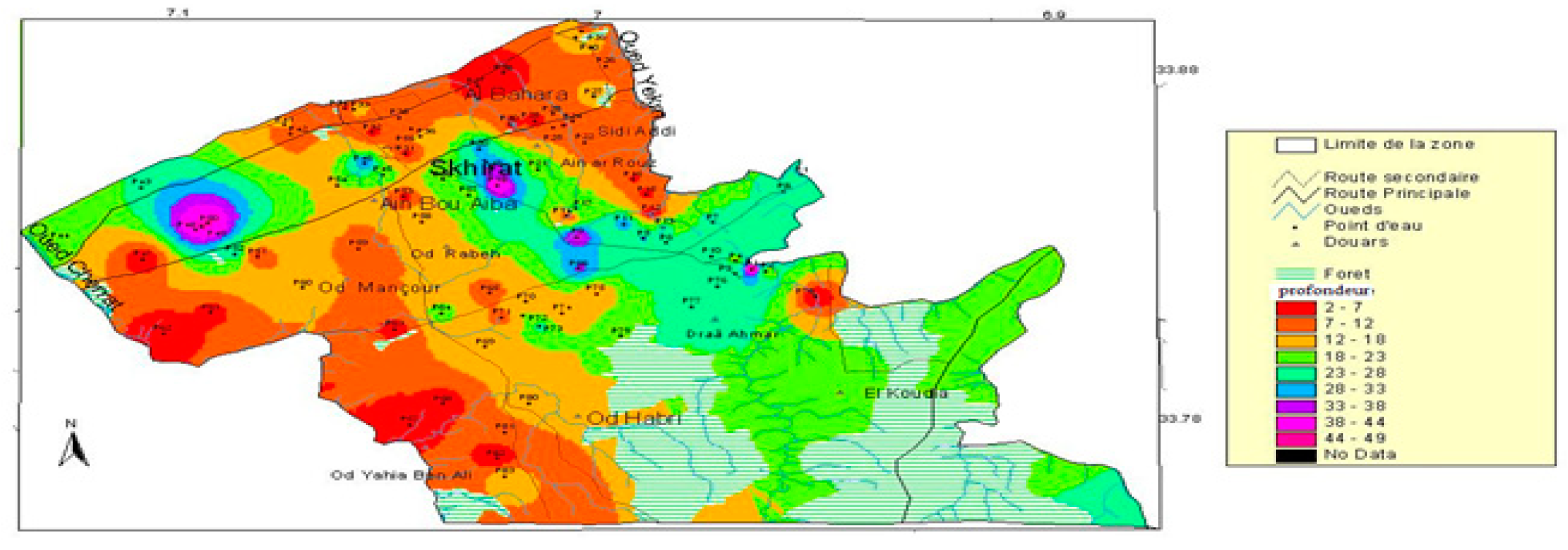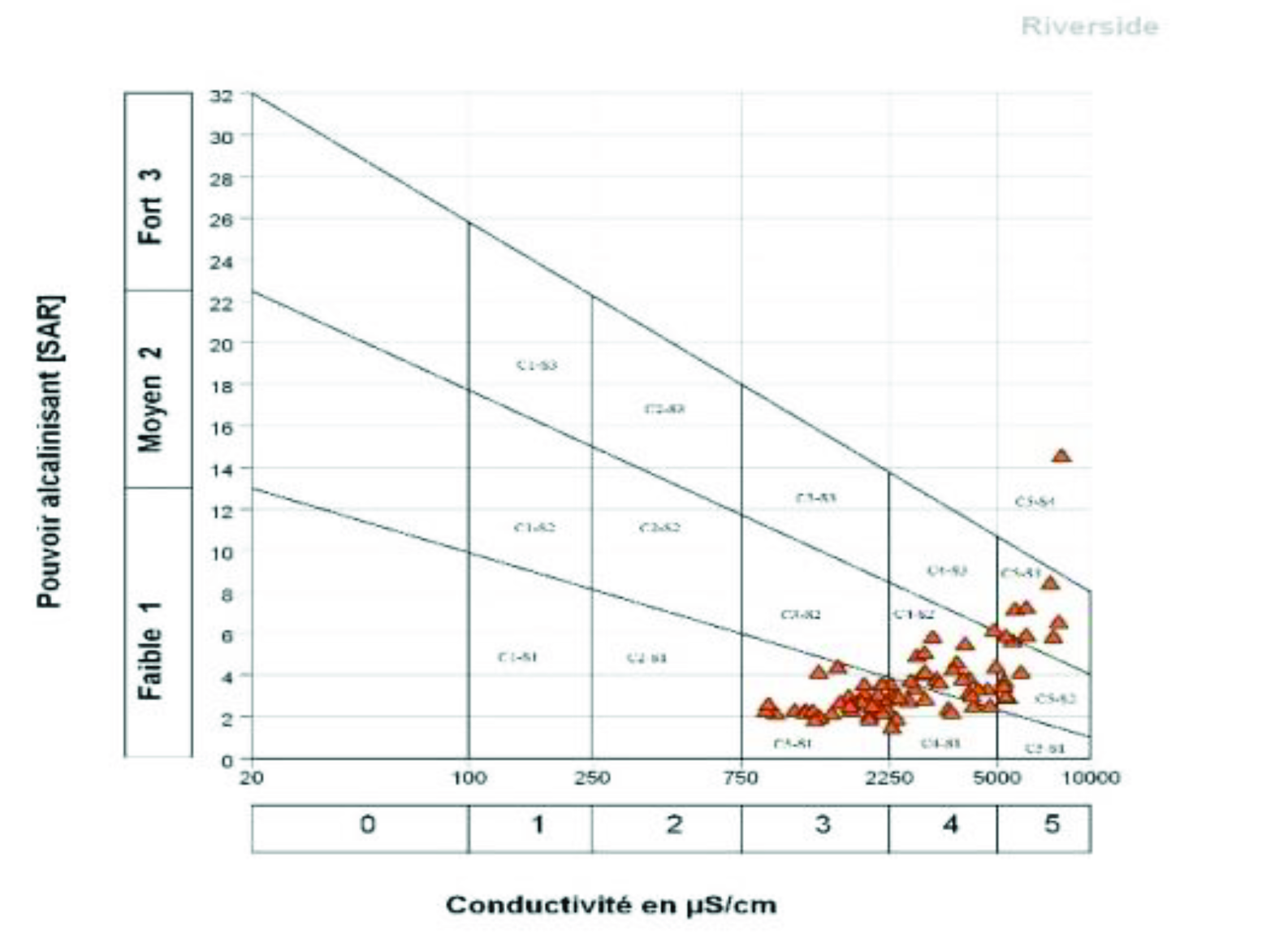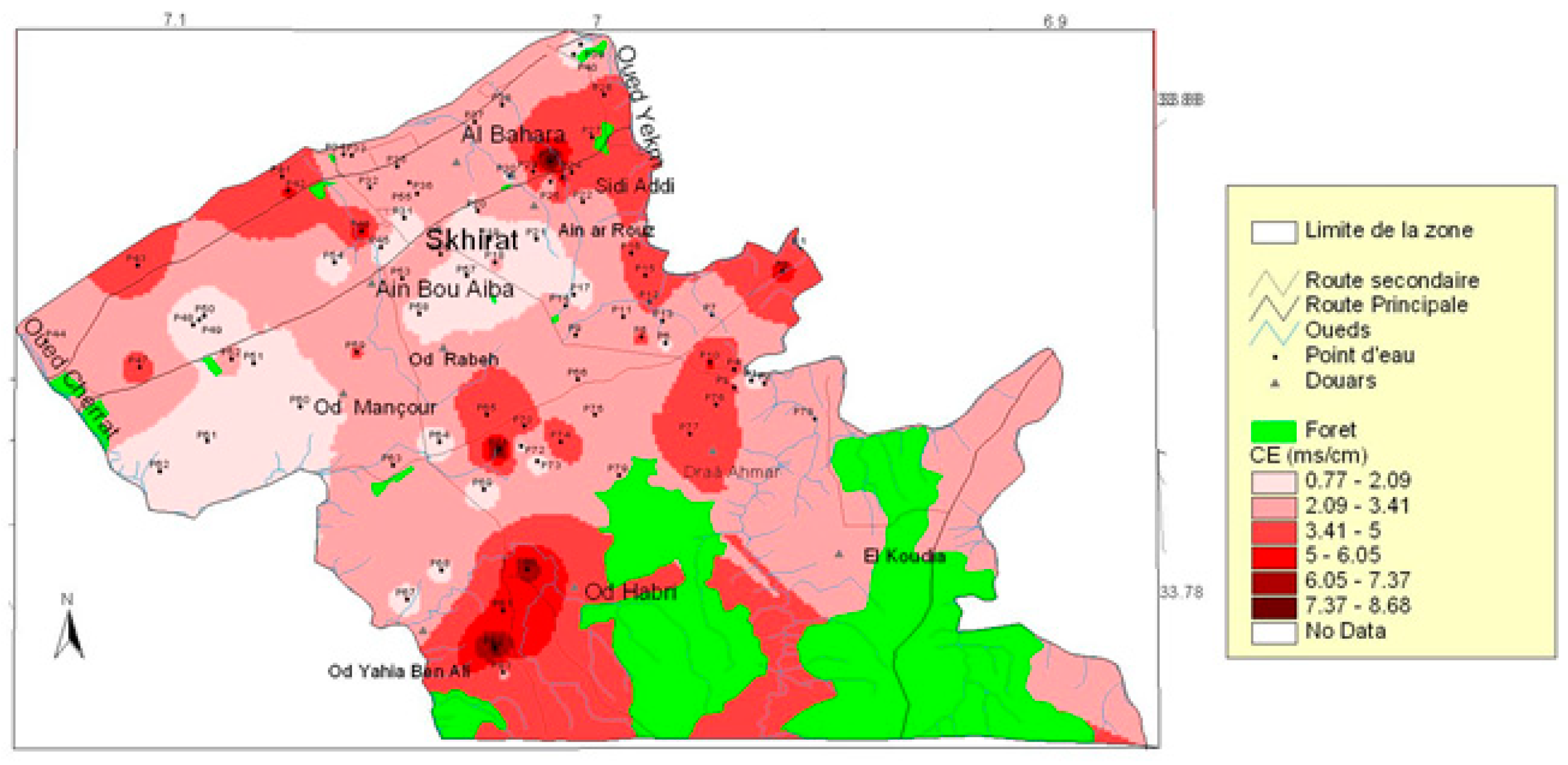Mapping and Analysis of Irrigation Water Quality in the Coastal Region of Skhirat, Morocco †
Abstract
:1. Introduction
2. Material and Methods
2.1. Study Area
2.2. Water Sampling and Laboratory Analysis
2.3. Mapping
3. Results and Discussion
3.1. Groundwater Depth
3.2. Chemical Facies of Waters
3.3. Water Salinity and Alkalinity
3.4. Water Salinity Mapping
4. Conclusions
Author Contributions
Funding
Institutional Review Board Statement
Informed Consent Statement
Data Availability Statement
Conflicts of Interest
References
- Devkota, K.P.; Devkota, M.; Rezaei, M.; Oosterbaan, R. Managing salinity for sustainable agricultural production in salt-affected soils of irrigated drylands. Agric. Syst. 2022, 198, 103390. [Google Scholar] [CrossRef]
- Dakak, H.; Huang, J.; Zouahri, A.; Douaik, A.; Triantafilis, J. Mapping soil salinity in 3-dimensions using an EM38 and EM4 Soil inversion modelling at the reconnaissance scale in central Morocco. Soil Use Manag. 2017, 33, 553–567. [Google Scholar] [CrossRef]
- Sehlaoui, H.; Hassikou, R.; Dakak, H.; Zouahri, A.; El Hasini, S.; Iaaich, H.; Ghanimi, A.; Douaik, A. Nitrate contamination and associated health risks of the Benslimane groundwater, Morocco. Environ. Geochem. Health 2022, 1–16. [Google Scholar] [CrossRef] [PubMed]





| Salinity and Alkalinity Class | Interpretation | % of Wells |
|---|---|---|
| C3-S1 | Average to poor quality. Use with caution. | 39 |
| C4-S1 | Poor quality. Exclude sensitive plants and heavy soils. | 16 |
| C4-S2 | Poor quality. To be used, with great care, only in light soils. | 29 |
| C5-S2 | Very poor quality. To be used only in exceptional circumstances. | 1.5 |
| C5-S3 | Very poor quality. To be used only in exceptional circumstances. | 13 |
| C5-S4 | Very poor quality. To be used only in exceptional circumstances. | 1.5 |
| Salinity Class | Symbol | EC (dS/m) | Number of Wells | % of Wells |
|---|---|---|---|---|
| No saline | C1 | <0.25 | 0 | 0 |
| Moderately saline | C2 | 0.25–0.75 | 0 | 0 |
| Strongly saline | C3 | 0.75–2.25 | 31 | 40 |
| Very strongly saline | C4 | 2.25–5 | 32 | 42 |
| Extremely saline | C5 | >5 | 14 | 18 |
Publisher’s Note: MDPI stays neutral with regard to jurisdictional claims in published maps and institutional affiliations. |
© 2022 by the authors. Licensee MDPI, Basel, Switzerland. This article is an open access article distributed under the terms and conditions of the Creative Commons Attribution (CC BY) license (https://creativecommons.org/licenses/by/4.0/).
Share and Cite
Mariami, I.; Dakak, H.; Zouahri, A.; Douaik, A.; Iaaich, H.; Cherkaoui Dekkaki, H.; Yachou, H.; Ghanimi, A. Mapping and Analysis of Irrigation Water Quality in the Coastal Region of Skhirat, Morocco. Environ. Sci. Proc. 2022, 16, 20. https://doi.org/10.3390/environsciproc2022016020
Mariami I, Dakak H, Zouahri A, Douaik A, Iaaich H, Cherkaoui Dekkaki H, Yachou H, Ghanimi A. Mapping and Analysis of Irrigation Water Quality in the Coastal Region of Skhirat, Morocco. Environmental Sciences Proceedings. 2022; 16(1):20. https://doi.org/10.3390/environsciproc2022016020
Chicago/Turabian StyleMariami, Ibtissam, Houria Dakak, Abdelmjid Zouahri, Ahmed Douaik, Hamza Iaaich, Hinde Cherkaoui Dekkaki, Hasna Yachou, and Ahmed Ghanimi. 2022. "Mapping and Analysis of Irrigation Water Quality in the Coastal Region of Skhirat, Morocco" Environmental Sciences Proceedings 16, no. 1: 20. https://doi.org/10.3390/environsciproc2022016020
APA StyleMariami, I., Dakak, H., Zouahri, A., Douaik, A., Iaaich, H., Cherkaoui Dekkaki, H., Yachou, H., & Ghanimi, A. (2022). Mapping and Analysis of Irrigation Water Quality in the Coastal Region of Skhirat, Morocco. Environmental Sciences Proceedings, 16(1), 20. https://doi.org/10.3390/environsciproc2022016020






